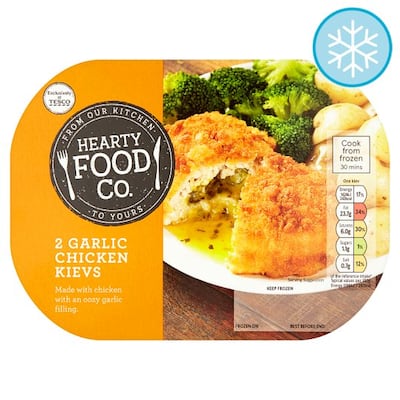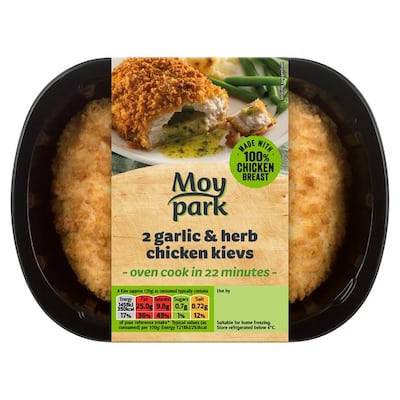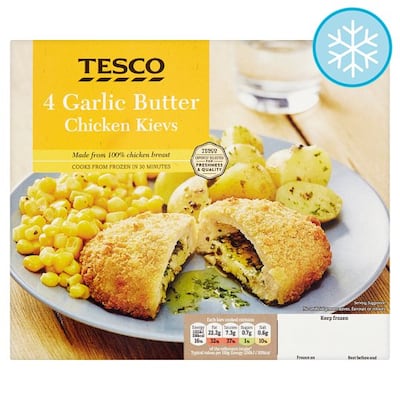Chicken Kiev is prime comfort food. Juicy meat coated in breadcrumbs and stuffed with herby butter, it goes perfectly with mashed potatoes and vegetables. It's a simple dish, but not so easy to make given the need to cut open the raw flesh and stuff it neatly before cooking. So it's hardly surprising the ready-made version is popular in supermarkets, though the 1970s are long gone.
There is quite a range available, some stuffed with just garlic butter and herbs, others with cheese, and even ham.
So what can the label tell us about what we are eating?

Quite a lot it seems. Take Hearty Food's Chicken Kiev. A label on the front says, "From our kitchen to yours", which sounds lovely and homely. But their kitchen belongs to Tesco, as does the brand, which was introduced to replace its Everyday Value range. The product is inexpensive, but the list of ingredients is long, at more than 40 items, and not very heart-warming.
The product has just 34 per cent chicken, while most other brands seem to have closer to 50 per cent. The second ingredient on the list here is water. We may not pay for water at home, but we often do when we buy cheap food products.
The dish includes textured wheat protein, which food ingredient sellers say is a great replacement for meat as it has little impact on taste or texture. There is also pea fibre and pea starch, which can be used to help water bind to meat and is used in place of modified starch.
What is not listed in the ingredients is butter. There is rapeseed oil, palm oil, sunflower oil, dried skimmed milk and enzymes, which is probably how they come up with a butter-like filling to go with the parsley and garlic extract. Butter is generally considered an expensive ingredient for the food industry to work with, so substitutes help them to keep costs down. This product also has flour and sugar in the form of dextrose.

Dizzying list
Then there is a dizzying list of processing aids which do little more than help to make the food manufacturer’s life easier. Citric acid, sodium carbonate and lactic acid are cited as acidity regulators; trisodium citrate, mono- and di-glycerides of fatty acids, mono- and di-acetyl tartaric acid esters of mono- and di-glycerides of fatty acids work as emulsifiers; xanthan gum, calcium lactate and tragacanth (gum) are used as stabilisers; tartaric acid and citric acid are used as antioxidants, which help to prevent spoilage; calcium silicate is used to prevent caking; ascorbic acid is described as a flour treatment agent; enzymes can help enhance food flavour; beta-carotene is used to give the crust the nice golden colour.
There is also concentrated lemon juice and rosemary extract. Lurking near the end of the list is ethanol, which is as a form of alcohol. It can be used to bring out the colour or flavour, or as a preservative.
Tesco observes the traffic light system, so the packet has a red label for fat, with amber for saturates and salt. Red for stop seems appropriate here.
A packet of Chicken Kiev from Moy Park has more chicken at 55 per cent and few processing aids, but uses rapeseed oil and margarine as well as butter.

Another Tesco product, Garlic Butter Breaded Chicken Kiev, is a little more expensive, but for that you get a lot more chicken and lot fewer ingredients. The chicken used is breast and it makes up 54 per cent of the dish. The other ingredients include: breadcrumbs, butter, water, wheat flour, rapeseed oil, garlic purée, parsley, salt and black pepper.
It gets a red light for fat and saturates, but a green light for simplicity.
Most products on the market come somewhere between the two, so it is well worth reading the label.
By spending a little more you get a much better product.
FOOD LABELS SERIES
1) Being a successful shopper
2) Bread
3) Milk
4) Cereal
5) Rashers
6) Yoghurt
7) Soup
8) Hummus
9) Pasta sauce
10) Chinese ready meals
11) Frozen chips
12) Chilled fish
13) Egg
14) Chicken Kiev
15) Crisps
16) Mayonnaise
17) Baked beans
18) Tomato ketchup
19) Chocolate digestive biscuits









